The Nexus 7 (2013) Review
by Anand Lal Shimpi on August 22, 2013 6:00 PM ESTCPU Performance
The while the original Nexus 7 was fast for the money, the new Nexus 7 is just fast. Moving away from NVIDIA to Qualcomm, ASUS and Google settled on the APQ8064 Pro. Although we originally assumed this would be a quad-core Krait 200 based SoC, Brian's teardown revealed the part number 8064-1AA. What's special about that part number is it implies newer Krait 300 cores, making the SoC effectively a Snapdragon 600.
The CPU cores can run at up to 1.5GHz, putting it a bit lower than what we've seen from Snapdragon 600 based phones (e.g. HTC One tops out at 1.7GHz, while the US SGS4 hits 1.9GHz).
I was curious as to the impact of the lower frequency when combined with the potentially higher chassis TDP so I compared the Nexus 7 to the US Galaxy S 4. I turned to Geekbench because it offers a nicely woven mixture of single and multithreaded benchmarks, letting me look at peak available single core performance as well as what happens when multiple cores are active and working.
In this first graph we're looking at the first Krait 300 core running the workload. I've zoomed in to a small portion of the benchmark so we can get a better idea of CPU behavior:
The Nexus 7's CPU0 is almost always pegged at 1.5GHz whereas we see a lot of bursty thermal management on the smaller SGS4. This isn't unexpected, but what ends up happening is the sustained performance advantage drops from a peak theoretical max of 26% down to a more reasonable average gain of ~8%.
I was curious to see if multithreaded workloads showed any different behavior. Here we're looking at the fourth CPU core (CPU3). Note that it's not always active, which is why you see parts of the graph drop down to 0KHz. Once again we see similarly static behavior from the Nexus 7. Even with all four cores active, when you need the performance the Nexus 7 delivers a full 1.5GHz. These tests are short enough where we don't see tremendous swings in frequency, but once again we do see some frequency modulation in a smaller chassis.
The end result is that the Nexus 7's 1.5GHz Krait 300 cores are slower than what you'd get in a Galaxy S 4, however the gap isn't nearly as large as you'd expect it to be thanks to the larger chassis and how the platform is tuned. The Nexus 7 can run at 1.5GHz more consistently than Snapdragon 600 based phones can run at 1.7/1.9GHz.
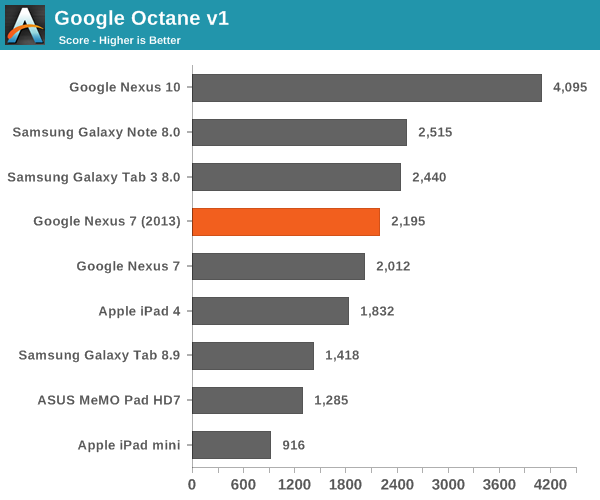


The GPU
Qualcomm seems to be frequency binning here, which is standard industry practice. Using binning to create these different SKUs gives Qualcomm pricing flexibility and also gives it the option to give large customers special treatment.
On the graphics side Qualcomm's Adreno 320 GPU makes an appearance. Clock speeds are also limited to 400MHz, compared to 450MHz for the high-end Snapdragon 600 implementations we've seen.
The APQ8064-1AA's dual-channel memory controller is populated with four x 16-bit DDR3L-1600 memory devices, giving the Nexus 7 a healthy amount of memory bandwidth. Peak memory bandwidth available to the APQ8064-1AA is 12.8GB/s, equalling what's available to Apple's A5X in the 3rd generation iPad with Retina display. Tons of memory bandwidth is obviously a pre-requisite for driving a high resolution display, and the combination of DDR3L-1600 and the Adreno 320 GPU delivers a butter smooth UI in all well written Android apps.
Although CPU performance is somewhat middle of the road compared to the rest of the landscape, GPU performance is faster than any other Nexus device on the market - and pretty much faster than any other similarly sized tablet:
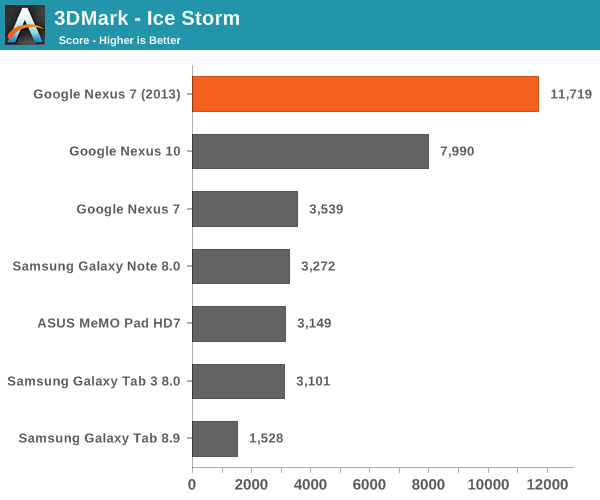
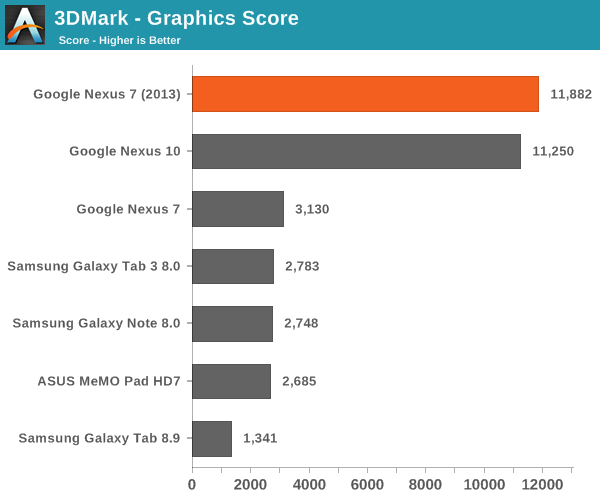
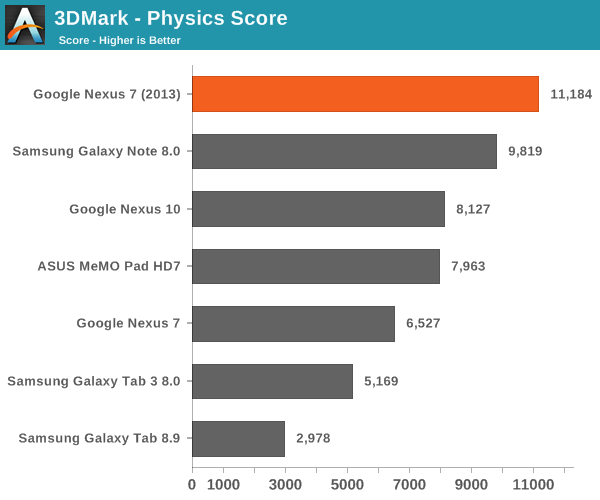
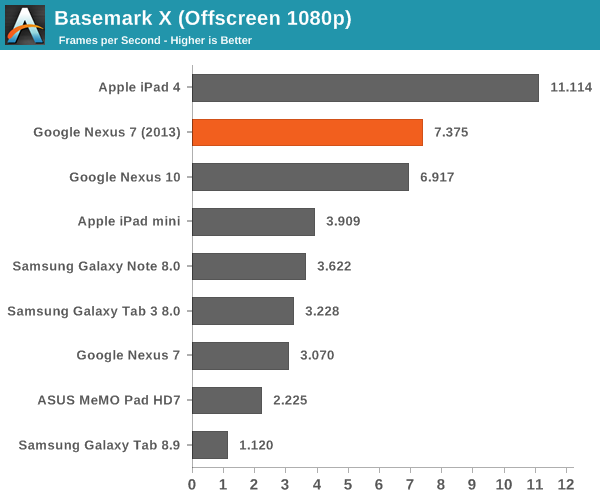
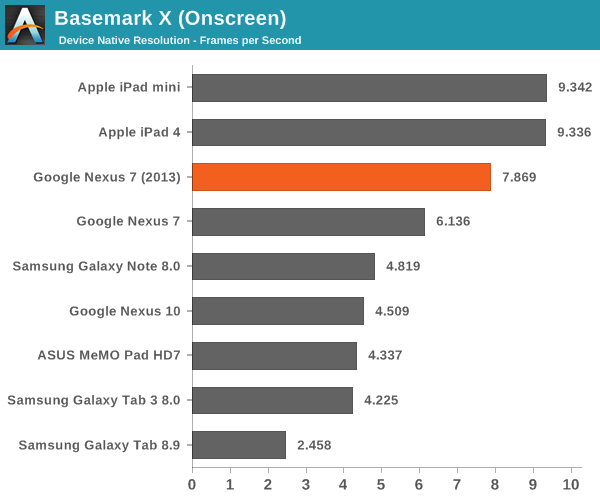
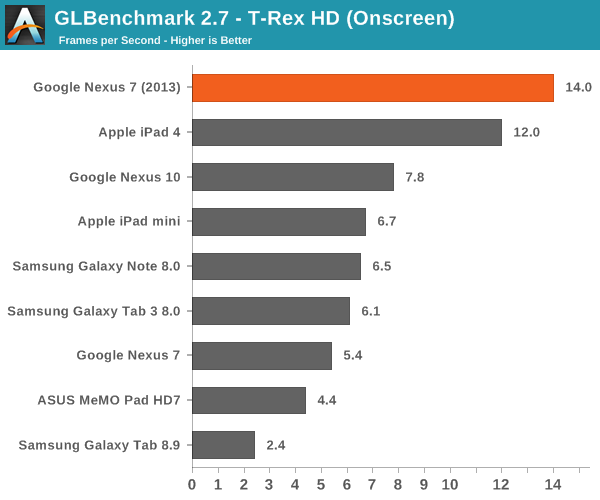
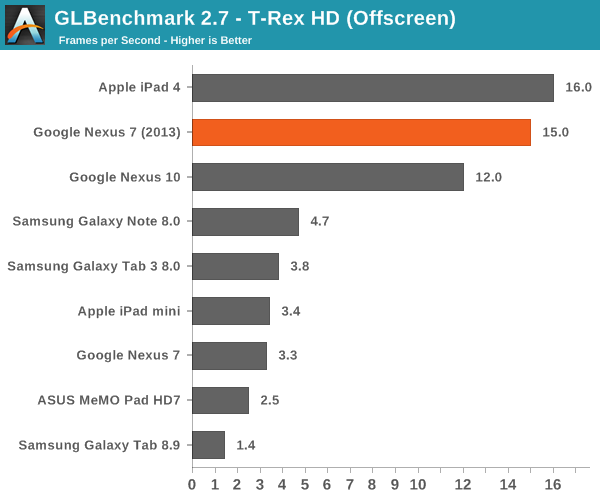
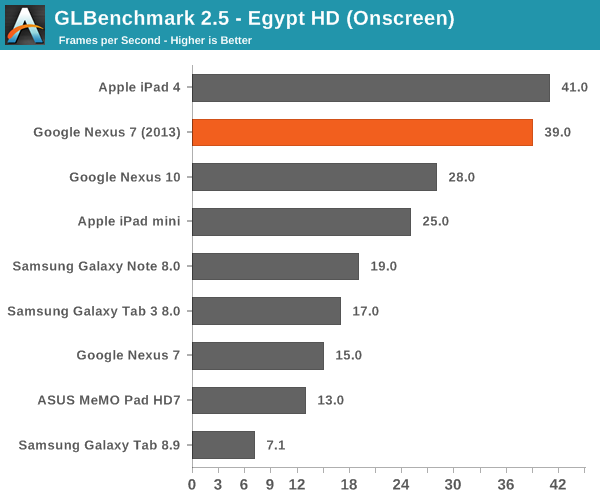
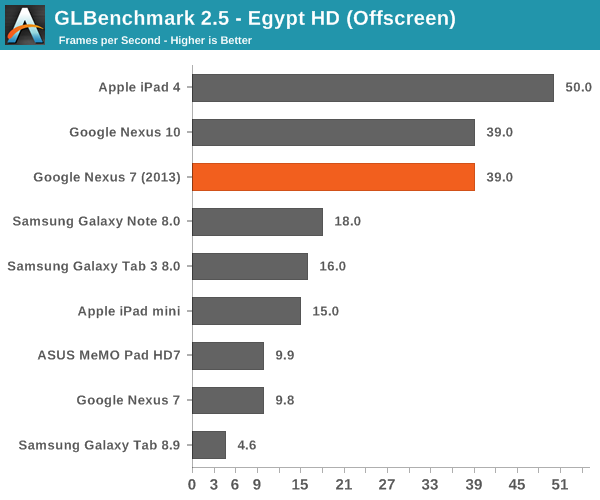
I played Modern Combat 4 as well as Shadowgun, both demanding 3D titles, on the new Nexus 7. Both titles appeared to render at the Nexus 7's native 1920 x 1200 resolution, and both appeared to do so at around 30 fps.


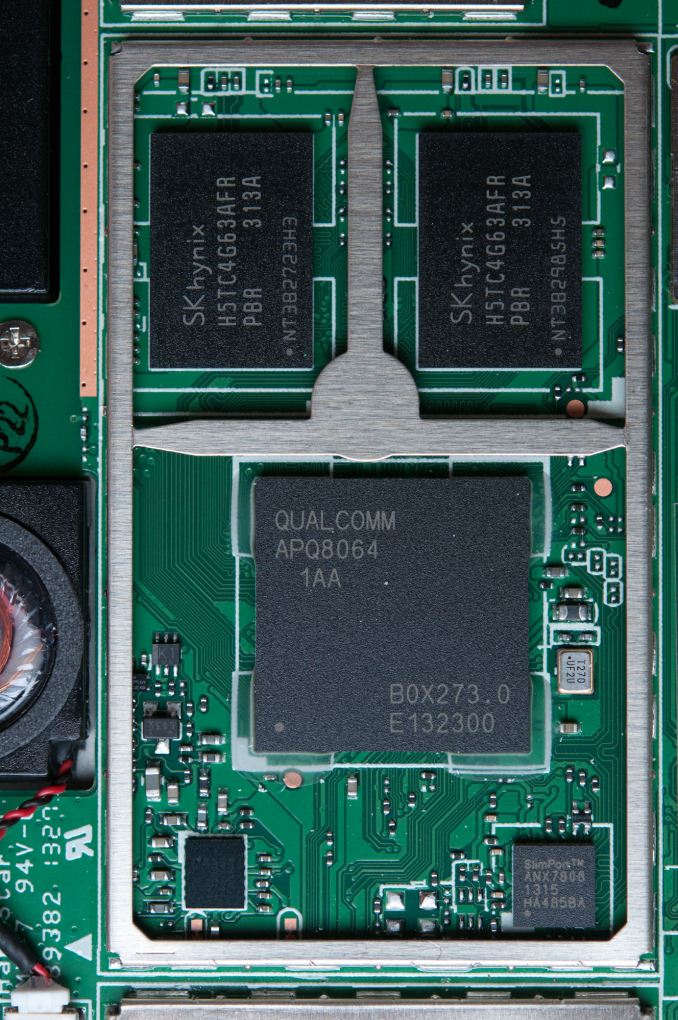
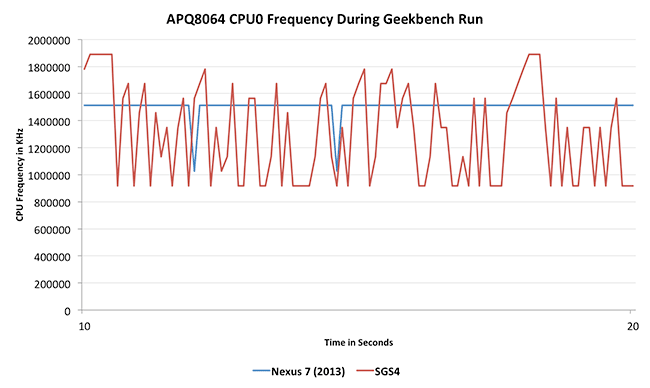
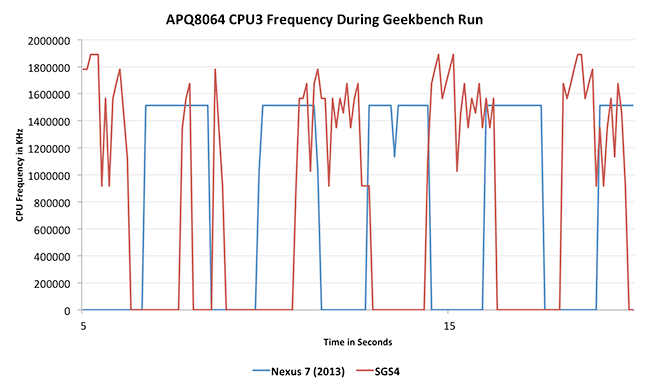








202 Comments
View All Comments
bubblesmoney - Wednesday, September 4, 2013 - link
Learn a bit more about android, quite a bit of what is state is inaccurate. Read all the parts, wanted to leave a comment on the blog but wasnt interested in leaving my email address on your website so didnt bother commenting there. Some simple things you need to know, get rid of the 'anti virus' you dont need it, you can read USB OTG hard drives, wifi drives, dvd players, cameras, wifi camera apps, dslr controller apps, miracast for wireless mirroring (does not need wifi for mirroring, stop comparing to airplay where you need a wifi signal, you dont need an app like you state in the article), nexus media importer can read NTFS hard drives, you can power hard drives with the nexus 7. So read up a bit more about android devices before writing a review as there is so much that is incorrect in the article (all parts) on your website. If you want to see wireless screen mirroring via miracast without using 'apps' or using hard drives etc then just search youtube for such videos or see my youtube channel veryannoyingname where i have uploaded hard drive being powered and read, dvd drive usb otg, etc you can also see some miracast videos so check it out if interested. See the other uploads and numerous playlists to use your android device better. Cheers.jb14 - Thursday, August 22, 2013 - link
Hi Anand thanks for the great review as always.I have a quick question for anyone here - i'm abit puzzled by the first two graphs on page one, ie the CalMAN display white point & Greyscale graphs. Here the Nexus 7 (2013) seems significantly worse than the original Nexus but there is no mention of this, however when the black levels are slightly worse on the new nexus in comparison this is picked up and explained. Am I missing something here or was the original nexus screen really that good in comparison, or do those two graphs have the nexus results the wrong way round so to speak? Are the differences too small to warrant highlighting? Thanks
darwinosx - Thursday, August 22, 2013 - link
Not a word about the fact that these are sold at cost.I have bought three of these as gifts but a retina iPad Mini will be a much better device when it arrives next month. 35 to 40% more screen real estate and real tablet apps instead of upsized apps plus three choices of memory sizes and LTE. This screen is too small for me though. Also the buttons are terrible.
sherlockwing - Thursday, August 22, 2013 - link
For 16:9 content, a 7.9" 4:3 screen only give you 13% more space. In exchange the Mini is almost an inch wider than N7 2013 while having much less bezel, not to mention Mini2 will end up being much more expensive than N7 2013 just like how N7 2012 vastly under priced the original mini.madmilk - Thursday, August 22, 2013 - link
I don't understand why people criticize the Nexus 4 and Nexus 7 for being sold nearly at cost. Are you really so eager to help Google, Apple, etc. make money? I'd prefer to keep it in my own pocket.BMNify - Thursday, August 22, 2013 - link
If subsidised hardware kill off the hardware manufacturer's then you will be left with a monopoly that is Google who can charge you more later and make money on Ad's too like they do now. This is the reason why selling at-cost or dumping is not desirable.sherlockwing - Thursday, August 22, 2013 - link
The sold at cost N7 is competing with the sold below cost Kindle Fire. The console market have the sold below cost Xbox competing with the sold below cost Playstation. Your logic doesn't work out in practice.BMNify - Thursday, August 22, 2013 - link
I have covered Amazon strategy in the below comments and console market is the perfect example of what will happen if all OS manufacturer's start dumping their hardware in the market. And console market is a much much smaller market where even 2-3 companies are enough but smartphones, tablets and laptops market is a very huge which needs healthy competition and many manufacturers to support all price points, device differentiation and quality.smartypnt4 - Thursday, August 22, 2013 - link
And? What's your point? How is it a negative that these are sold nearer to cost than Apple's 40%+ margin?Mivo - Friday, August 23, 2013 - link
End customers don't care if a device is sold at cost. I don't consider a low price a negative. The retina iPad mini won't be out next month, which is one of the main reasons why I now pre-ordered a N7 (hitting German shelves next week). I waited long enough.